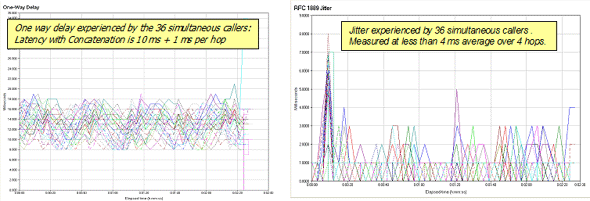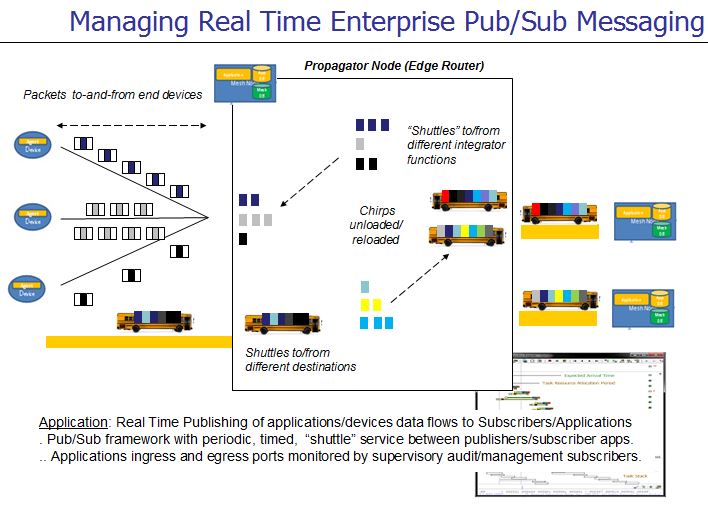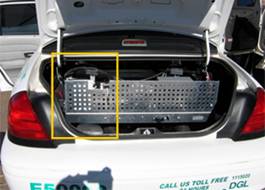 Overview
Overview:
Meshdynamics multi-radio multi-channel backhaul ensures
deterministic latency and jitter by eliminating both the
effects of single radio backhauls and involuntary contention.
Besides the inherently high performance of Meshdynamics'
patented multi-radio backhaul technology, additional
specialized voice features minimize delay and jitter.
These
features insure that voice is transported rapidly and
efficiently across the network, maximizing the number of voice
calls that may be supported while minimizing wasted bandwidth.
Meshdynamics multi-radio multi-channel backhaul ensures deterministic latency and jitter by eliminating
both the effects of single radio backhauls and involuntary contention.
Extensions for near isochronous M2M messaging is
discussed. This is relevant to the Mesh Node
Application Layer.
 Latency/Jitter Degradation on Single Channel Backhauls
Latency/Jitter Degradation on Single Channel BackhaulsLatency is inversely related to available bandwidth: thin pipes can provide only so much flow. Single channel backhauls suffering from bandwidth degradation also suffer from poor latency and jitter over multiple hops. This is primarily due to the need for a single radio to serve both backhaul and client traffic. The result is that most
First Generation single-channel backhaul networks provide reliable video- or voice service over only one- or two hops. As a result many more costly wired or fiber Internet or intranet drops are needed to deliver adequate service, increasing the ongoing total cost of ownership.
Third Generation mesh products do not suffer from
bandwidth degradation – they use multiple backhaul radios to obviate radio channel interference. Field tests indicate a latency of less than 1 millisecond per hop even under heavy traffic. Since latency is thus not a factor of traffic or user density, jitter (variation in delay) is also very low. This makes Third Generation products suitable for networks serving large number of users, demanding applications, video, and voice -- even simultaneously.
Meshdynamics patented multi-radio multi-channel backhaul ensures deterministic latency and jitter by eliminating
both the bandwidth degradation effects of single radio backhauls and
involuntary contention in multi-hop networks.
 Real Time Packet
Delivery Services optimized for Small Packets
Real Time Packet
Delivery Services optimized for Small Packets
Additionally, Meshdynamics multi-radio backhauls also incorporate
VOIP concatenation for timely VOIP packet delivery. VOIP packets are small – typically less than 300 bytes but sent frequently, generally once every 20 milliseconds.
Networking protocols like CSMA/CA don’t transport small and time sensitive packets well. The VOIP concatenation engine aggregates small VOIP packets into a larger packet for more efficient delivery. This aggregation takes place every 5-10 milliseconds.
USAF tests show overall latency is less than 10 ms + 1 ms per hop over a 4 hop network. Jitter is less than 1 ms. per hop.
 |
|
Figure
1a (left): Latency for 36 simultaneous VOIP calls over a 4 hop Mesh
running VOIP Concatenation over the backhaul.
Figure 1b (right): Jitter for 36 simultaneous VOIP calls over a 4 hop Mesh
running VOIP Concatenation over the backhaul. |
 Persistent Base VoiceTM (PBV)
Persistent Base VoiceTM (PBV)
Applications, like Persistent Base VoiceTM
(PBV) become feasible. when deterministic latency and
jitter is assured. With PBV, VOIP phones can function even when
the SIP gateway is not reachable: the mesh nodes act as a
temporary proxy SIP server till nodes rejoin the main mesh.
Beyond sharing SIP registries between previously isolated
network clusters, applications like PBV need accurate
estimates of when small packet deliveries occur. If
the bulk container shuttle bus schedule is inappropriately
timed, it will periodically miss small packet "herds" that
arrive around the same time. Schedules are
monitored and dynamically revised.
Please also see Press
Release Illustration
Patent
 M2M
Extensions For Industrial Internet of Things (IOT)
M2M
Extensions For Industrial Internet of Things (IOT)

With deterministic jitter and
latency in place, accurate estimates are computed on the
"round trip" delay from wireless end devices to cloud and
back. This information, computed periodically, is available to
applications
resident on the mesh nodes.
Machine to Machine (M2M) communications -- like VOIP
packets-- are typically terse and preferably isochronous.
Applications access current jitter and
latency for available routes. This helps determine optimal shuttle schedules for
their M2M messages.
Please see The
Abstracted Network for Enterprises and the Internet of Things. for
more.
 Related to VOIP
Concatenation Engine
Related to VOIP
Concatenation Engine
1.  Meshdynamics
receives Prestigious VIEW certification Certification received from Spectralink/Polycom
Meshdynamics
receives Prestigious VIEW certification Certification received from Spectralink/Polycom
2.  Meshdynamics
First With Persistent Voice Over Wireless Mesh VOIP calls
work even when no SIP server is present.
Meshdynamics
First With Persistent Voice Over Wireless Mesh VOIP calls
work even when no SIP server is present.
3.  Meshdynamics
Delivers Persistent Wi-Fi Network for Mobile Environments
Merging and dispersal in mobile networks
Meshdynamics
Delivers Persistent Wi-Fi Network for Mobile Environments
Merging and dispersal in mobile networks
4.  Wi-Fi
based Femtocell Extensions for the outdoor enterprise.
Extension of Femtocell coverage using mesh.
Wi-Fi
based Femtocell Extensions for the outdoor enterprise.
Extension of Femtocell coverage using mesh.
5.  VOIP and
VIDEO on a City wide scale Meshdynamics VOIP
Concatenation Engine explained.
VOIP and
VIDEO on a City wide scale Meshdynamics VOIP
Concatenation Engine explained.




